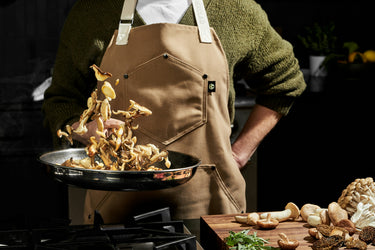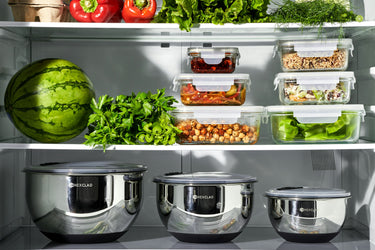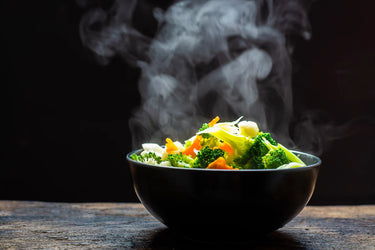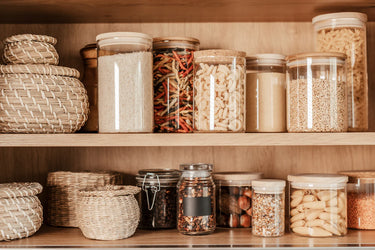How To Sauté in a Non-Stick Pan

Sautéeing might seem like an intimidating prospect, but the truth is that many home cooks have already done it without even realizing it.
If you have ever cooked vegetables or cuts of meat on high heat, it’s entirely possible that this is already a part of your cooking repertoire. If not, or if you would simply like to learn more about this important technique, this is the article for you.
What Does It Mean To Sauté?
Quite literally, “sauté” is the French word for “jump.” While this might not sound like the most appetizing verb, it is likely in reference to the motion of the food in the pan due to the high heat. Sautéeing is a preferred cooking method to effectively prepare vegetables, meat, and more only in a pan.
Whether you’re sautéeing to make a side dish or the entrée, you will always be operating on high heat. The goal of this technique is to cook with as little moisture as possible, causing the ingredients to brown in the pan.
What Is the Difference Between Sautéing and Frying?
Frying can represent a lot of different types of cooking. Deep frying in a vat of oil, stir-frying in a wok, and sautéeing in a pan all fit under the “frying” umbrella. In short, sautéeing is more specific than frying.
To sautée, you need higher heat and a minimal amount of oil, making it unique from some other cooking techniques.
How Do You Sauté in a Non-Stick Pan?
It is actually easier to sauté in a non-stick pan than it is to do it in another kind of pan. Not only will the result be better as you cook, but future-you will be thankful when you don’t have to toil away, scraping over the sink.
Add Oil and Preheat Your Pan
Let’s establish something right off the bat: you do still need to add oil to your pan, even if it is non-stick. It’s still important to create that barrier between the coating on the bottom of the pan and the food. That said, you only need a small amount of oil, and it doesn’t even have to cover the entire surface area of the frying pan.
Add a small amount of fat (olive oil, ghee, canola oil, and coconut oil can all work, but choose fat with a high smoke point). Then, set the stove to medium-high heat. The goal is to have a relatively low cook time and not add extra moisture — this is what makes ingredients turn a lovely golden brown as the food cooks.
The ability to heat the entirety of the pan evenly is non-negotiable, especially when it comes to sautéeing. You need all of your components to heat at the same rate, whether they’re on low heat or high. This is where HexClad Hybrid Pans shine. And we mean literally shine, thanks to the stainless steel outside.
These pans’ hybrid technology provides the best of both a cast iron and a stainless steel pan, all in one sleek package. The entire bottom of the pan heats evenly, every time. You never have to worry about burning your hand on the handle, though. Our handles are imbued with stay-cool technology to keep you safe and comfortable.
Keep Your Ingredients Uniformly Sized
You may think that the perfect sauté only happens in the pan, but the truth is that the process starts much earlier than that. Before you even turn the range on, you’re already setting the scene for either a perfect result or an inconsistent one.
You want to have your ingredients on hand and ready for whenever they need to go into the sauté pan. As a result, cutting, chopping, dicing, or mincing your ingredients while you’re in the middle of cooking is not a good idea.
All that will get you is a sense of panic and the need to rush since you can’t pay full attention to the ingredients in the pan. Inevitably, you will end up putting certain ingredients in too late, so veggies that were added in earlier will be overdone. Instead, you need to take the time to prep all of your ingredients before heating up the pan.
This concept is known as “mise en place,” which is French for “everything in its place.” It helps you become more organized and less frazzled in the kitchen by having as many components already prepared as possible.
In addition, you should keep them nearby so that you never have to waste precious time searching for anything. Let’s say you’re making sautéed vegetables, and you’re cutting up a bell pepper before it’s ready for the stovetop. You may want longer, matchstick-like pieces of pepper, you may want it diced, or you may be aiming for something in the middle.
The shape you choose to cut your ingredients into is up to you and what fits best with your dish. However, you do have to make sure that each individual piece is roughly the same size.
If your food is all different sizes, they will cook at different rates. The last thing you want is for some pieces of food to become beautifully caramelized, while others are nowhere near your desired level of doneness. This rule applies even more heavily when it comes to the cooking process for sautéeing meat like chicken breast. Make sure that all of the pieces are even so that the meat will be fully cooked and safe to eat.
Add Your Ingredients, But Avoid Overcrowding Your Pan
Even the highest-quality pan that heats perfectly can only do so much if you’ve put food on top of itself or aren’t giving it room to breathe. This cooking technique requires that your ingredients are laid down in a single layer rather than piled up.
If you have too many ingredients, you can either use a larger pan or cook ingredients in batches. No matter what, you need to allow each ingredient to get its own quality time with the hot pan rather than using the residual heat to cook. If each piece doesn’t get a chance to sizzle, your sauté won’t be uniform.
Cook Until Softened or Golden
The exact cook time of any sauté will depend on the ingredients you’re using. Minced onions, for instance, will be done quite quickly. Larger chops of meat will take much longer. Keep pan-frying the ingredients until they have reached the color and texture you want. If you’re cooking meat, remember that there is a minimum internal temperature you have to reach before it’s safe.
Is a Non-Stick Pan Best for Sautéing?
Since sautéeing relies on using such a small amount of fat to lubricate the pan, it is absolutely best to use a non-stick pan. With other kinds of cookware, the ingredients can easily fuse to the surface, creating a distinctly unappetizing… well, mess.
When you’re using non-stick pans, you are supposed to use only a bit of oil. This makes non-stick pans incredibly compatible with sautéeing as a cooking method.
HexClad Pans for a Perfect Sauté
We know it’s better to use a non-stick pan for your sauté, but some non-stick pans are better than others. With the right type of pan, each step of the cooking experience will be easier, more enjoyable, and safer.
HexClad Hybrid Pans are created with a non-toxic coating that lets your food slide right off. Once the pan has served its purpose and cooled off, it can be put directly in the dishwasher for the easiest clean-up of your life.
Sources:
Know Your Cooking Oil Smoke Points | VeryWellFit
What Is Mise En Place? | The Spruce Eats
Safe Minimum Internal Temperature Chart | Food Safety and Inspection Service





